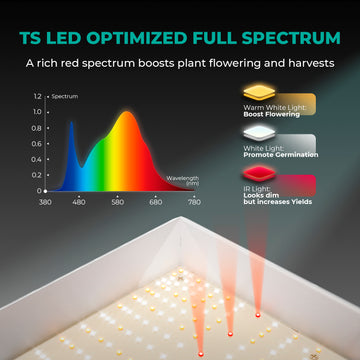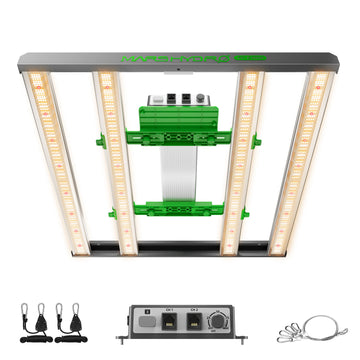Unveiling the Magic of Seeds: Secrets to Successful Seed Selection and Germination
Choosing the right seeds and ensuring their successful germination are crucial steps that lay the foundation for a bountiful harvest and a flourishing garden landscape. However, the process can sometimes seem overwhelming, with countless seed varieties available and intricate factors influencing germination success. That's why understanding the secrets to successful seed selection and start seeds indoors can empower gardeners with the knowledge and confidence needed to cultivate healthy and vibrant plants.
In this guide, we will delve into the secrets and key principles that unlock the potential of seeds, helping you make informed choices and master the art of germination.
Importance of Seed Selection and Germination in Gardening

Lay the foundation for a successful and productive garden. The quality and characteristics of the seeds chosen directly impact the growth, vigor, and yield of plants. By carefully selecting seeds that are well-suited to the specific growing conditions, gardeners can set themselves up for success right from the start. Whether it's choosing disease-resistant varieties, climate-adapted seeds for planting, or plants with desirable traits, seed selection plays a vital role in determining the overall health and productivity of a garden.
Germination, the process by which a seed develops into a seedling, is the magical moment when the potential within a tiny seed is unleashed. It is during germination that the dormant embryo within the seed comes to life, sprouting roots and shoots that will eventually develop into a full-grown plant. The successful germination of newly planted seeds ensures a strong and healthy start for plants, enabling them to establish robust root systems and absorb nutrients efficiently from the soil. Besides, proper germination also enhances plants' ability to withstand environmental stresses, such as extreme temperatures or drought, thereby increasing their chances of survival and overall resilience.
Additionally, seed selection and germination play a crucial role in maximizing the efficiency of gardening efforts. By carefully choosing seeds that have desirable traits, such as early maturity, compact growth habits, or high yields, gardeners can optimize their use of space, time, and resources. Furthermore, selecting seeds with staggered germination and maturity times allows for succession planting, ensuring a continuous harvest throughout the growing season. This strategic approach to seed selection and germination can greatly increase the overall productivity and abundance of a garden.
Beyond the practical benefits, seed selection and germination also contribute to the aesthetic appeal of a garden. By choosing seeds for plants with striking flowers, vibrant foliage, or unique forms, gardeners can create visually captivating landscapes that delight the senses and evoke a sense of beauty and tranquility.
Factors to Consider When Choosing Seeds

Climate and Growing Conditions: One of the most critical factors to consider is the climate and specific growing conditions in your region. Some plants thrive in cooler temperatures, while others prefer warmer climates. Take into account factors such as average temperature, rainfall, humidity, and sunlight availability. Please choose seeds for planting that are well-suited to your particular climate and growing conditions to ensure optimal growth and productivity.
Plant Varieties and Characteristics: Different plant varieties have distinct characteristics that can significantly impact their performance in your garden. Consider factors such as growth habit (bushy, vining, compact), height, spread, and overall size. Determine if you prefer plants that produce an abundance of flowers, foliage, or edible fruits. And assess whether you need plants with specific qualities such as disease resistance, pest tolerance, or heat tolerance. By understanding the characteristics of different plant varieties, you can choose seeds for planting that align with your preferences and garden goals.
Purpose and Use: Consider the purpose for which you're growing the plants. Are you looking to cultivate a vegetable garden, create a colorful flowerbed, establish an herb garden, or attract pollinators? Each purpose requires different types of plants. Determine the specific uses and functions you want your garden to serve and select seeds accordingly. This ensures that the plants you grow align with your intended goals and maximize the benefits you desire.
Space and Garden Layout: Evaluate the available space in your garden and the layout you envision. Some plants require more room to spread and grow, while others can be grown in seed starting containers or compact spaces. Consider the mature size and growth habits of plants when planning your garden layout. This helps you optimize space usage and avoid overcrowding, promoting healthy growth and facilitating ease of maintenance.
Time and Maintenance Commitment: Different plants have varying needs in terms of maintenance and time commitment. Some plants require regular watering, pruning, or fertilization, while others are more low-maintenance. Assess the amount of time and effort you're willing to dedicate to your garden and choose seeds accordingly. Select plants that align with your desired level of involvement and the time you can devote to caring for them.
Personal Preferences and Aesthetics: Ultimately, gardening is a personal endeavor, and your preferences and aesthetics play a vital role in seed selection. Consider the colors, textures, and scents that you find appealing. Determine the overall style or theme you want to achieve in your garden, whether it's a cottage garden, a modern landscape, or a wildlife-friendly sanctuary. Choose seeds that align with your personal tastes and create a garden that brings you joy and satisfaction.
Secrets to Successful Seed Germination

This section provides a comprehensive guide to ensure successful seed germination for growers. Instead of relying on trial and error, follow this practical blueprint to achieve healthy young seedlings from your seeds.
Proper Disinfection Is Essential
It is crucial to disinfect your indoor seed starting equipment to prevent the growth of harmful microorganisms that can hinder germination. If you are reusing seed trays and flats, always disinfect them to avoid mold on seedlings and seed damping, which is caused by seedling blight, a soil-borne disease that can kill seedlings. Typically, a combination of clean water and bleach can be used for equipment disinfection.
Pay Attention to Seed Packets
Your seed packet contains valuable information on the seeds and how to germinate seeds successfully. Look for details such as the complete plant name, description (including color, dimensions, pollinators attracted, bedding uses, etc.), production company, price, weight, and other designations indicating whether the seed is certified organic, non-GMO, hybrid, or open-pollinated. The seed packet may also provide information on planting depth, shade/sun requirements, days to germination, pre-planting preparation, harvest, soil/moisture needs, and more.
Use A Specialized Soil Mix for Seed Starting
Utilize a soil mix specifically formulated for seed germination. Unlike potting mix soil, a seed starting soil mix has finer particles that facilitate root growth and provide extended moisture. A typical seed starting mix may contain screened compost, perlite, vermiculite, and rehydrated coir in varying proportions. You can either purchase a pre-made seed starting mix or create your own, which can be cost-effective and allow you to have complete control over the mix composition.
Sufficient Light Is Essential
Different plant species have varying light requirements for seed germination. Some vegetable seedlings require darkness, while others need both dark and light conditions to sprout. Light acts as an external trigger for the germination process in certain vegetable seeds. Additionally, once the seeds have successfully germinated, light becomes crucial as the energy source for the initial seeds sprout. Growers use various light sources to meet these requirements, and LED grow lights are recommended for their efficiency and effectiveness in providing high-quality grow light for seed germination. If you're looking for reliable, full-spectrum LED grow lights with low heat output and high energy efficiency, consider exploring the options available at Mars Hydro.
Adequate Water Is Necessary for Fertilization
Water plays a vital role in seed fertilization. The embryo of the seed only ruptures after absorbing enough water from the environment. During hot months, the root tip of the embryo reaches deeper into the garden soil to absorb water, ensuring the vegetable seeding and germinating embryo have sufficient moisture and keep soil moist for proper growth.
7 Common Seeds Germination Mistakes You Need to Avoid
Here are seven common mistakes to avoid during seed germination to ensure a smooth and successful process.
Avoid Using Low-Quality Seeds.
It is crucial to ensure that the seeds you plant are viable and of high quality. Using poor-quality seeds can result in low or no germination at all. While seed banks are a common source, it's important to note that seeds lose viability over time, especially when stored under regular room-temperature conditions.
Use Safe Containers and Sterilize Planting Materials.
A common mistake in seed germination is neglecting to sterilize planting materials, which can lead to mold and fungal infections that hinder germination. If you are reusing plastic containers, make sure to properly sanitize them to prevent any contamination.
Avoid Planting in Deficient Soils.
Soil quality is crucial for successful seed germination. The soil should contain all the essential nutrients and beneficial microorganisms necessary for healthy growth. While using soil from your backyard may seem convenient, it can hinder seed germination and result in weak seedlings. Opt for light, well-aerated soil with excellent drainage for optimal germination.
Avoid Overwatering or Underwatering.
While moisture is important for seed germination, it's essential to strike a balance. Overwatering can lead to damping off and fungal diseases, while underwatering can cause wilting and poor germination. Maintain a consistent watering schedule where the top layer of soil dries out before watering again for best results.
Plant Seeds at the Correct Depth.
Planting seeds at the wrong depth can impede germination. Different seeds have specific spacing and depth requirements based on their shape and size. Refer to the information provided on the seed packet to determine the proper spacing, aeration, and depth for your seeds. It is essential to read the seed packet before planting.
Provide Optimal Temperature Conditions.
The temperature of the soil plays a crucial role in seed germination. Extreme temperatures, whether too low or too high, can result in poor germination or seed dormancy. It's important to maintain the optimal temperature range for your seeds to ensure successful germination. If necessary, use a grow tent, heat mat or other grow equipment to provide your indoor plants the optimal temperature!
Avoid Using Fertilizer Initially.
Germinating seeds do not require fertilizer for germination as they can rely on their stored nutrients during the early stages. Wait until at least two sets of true leaves have emerged before considering the use of fertilizers. Starting seeds with a quarter dose of balanced liquid feed and gradually increase the amount over time.
Final Thoughts
As a grower, it is essential to dedicate effort to create the ideal environmental conditions for the emergence of new plants from seeds. This particular aspect poses a challenge for many growers, as the process of seed germination is delicate and a single misstep can hinder desired outcomes.
To choose the best seeds and ensure successful seed germination, follow the recommendations provided in this article and take note of the mentioned mistakes to avoid.
Wishing you the best of luck in your gardening endeavors.



![[Top Choice for Beginner] Mars Hydro TS 1000 Full Spectrum 150W LED Grow Light Sunlike Dimmable Lamp for Hydroponics Indoor Veg Flower](http://marshydroled.ca/cdn/shop/files/MarshydroTS1000LEDOPTIMIZEDFULLSPECTRUM_360x.jpg?v=1721204369)





![[Best LED for 4'x2'] Mars Hydro TSL 2000 300W LED Grow Lights Veg Flower Plants Growth Lamp Hydroponics](http://marshydroled.ca/cdn/shop/files/MarsHydroTSL2000LEDOPTIMIZEDFULLSPECTRUM_360x.jpg?v=1721204015)




![[Most Economy 300W LED] Mars Hydro TSW 2000 300W Dimmable Full Spectrum LED Grow Light for Hydroponics Indoor Tent Box Veg Bloom](http://marshydroled.ca/cdn/shop/files/Mars_HydroTSW2000_PPFD_360x.jpg?v=1721202922)


















